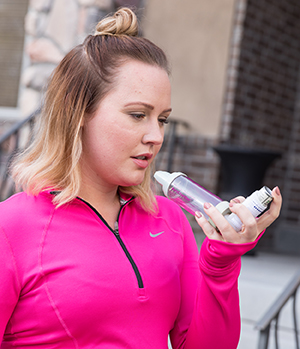Understanding Perimenstrual Asthma (PMA)
Perimenstrual asthma (PMA) occurs when a woman’s asthma symptoms get worse right before or during her menstrual period. Asthma flare-ups can occur. And asthma symptoms can be more severe during this time. A person with PMA may need to go to the emergency room or be admitted to the hospital. About 3 in 10 women with asthma have PMA.
Causes of PMA
Experts don’t know the exact cause of PMA. But it may be from changes in the levels of estrogen and progesterone. These changes have been linked to changes in asthma symptoms and inflammatory responses just before the menstrual period in women with asthma.
Who is more likely to get PMA?
PMA often affects women with asthma who:
-
Are older.
-
Have more severe asthma.
-
Are overweight.
-
Are very sensitive to aspirin.
-
Have menstrual cramps.
-
Have premenstrual syndrome.
-
Have irregular menstrual cycles.
-
Have longer menstrual bleeding.
Symptoms of PMA
With PMA, severe asthma symptoms occur just before or during your menstrual period. These symptoms include:
-
Wheezing.
-
Chest tightness.
-
Shortness of breath.
-
Cough.
People who have PMA attacks are more likely to be treated in the hospital. Symptoms may be so severe that they may also need help with their breathing using an invasive mechanical breathing device (ventilator). In some cases, these attacks can be fatal.
Diagnosing PMA
Your doctor will do a physical exam and take your health history. They will ask about any changes in your asthma symptoms. Watch your symptoms closely. Record any changes and when they occur. Also record the dates of your menstrual cycles. It’s important to write down and find or rule out the cause of any asthma flare-ups or symptoms that get worse. Always bring this record of your symptoms to your doctor visits.
Treatment for PMA
Asthma medicines are key in treating PMA. To help with symptoms, your doctor may advise you to increase your dose of asthma-control medicine before your period starts. Or your doctor may have you take a different medicine.
Create an Asthma Action Plan with your doctor. Update your Asthma Action Plan each year, or when you see your doctor. Bring your plan if you go to the emergency room for a flare-up.
There are different types of asthma medicines. You may need to take more than 1 as advised by your doctor. Talk with your doctor to be sure you know how to use all of your medicines correctly. Asthma medicines often used to treat PMA may include:
-
Quick-relief (rescue) medicine. These medicines are fast-acting. They give you quick relief when your symptoms start. They relax and open up the airways. Take these medicines only when needed. Always carry this medicine with you.
-
Long-term control (maintenance) medicine. These medicines help relax the muscles around your airways. They are often taken on a schedule. Don't skip doses unless your doctor tells you to. They are often combined with inhaled corticosteroids.
-
Inhaled corticosteroids. These medicines work to reduce airway swelling and inflammation. These medicines are often taken for severe symptoms. They open up the airways. They are inhaled right into the bronchial tubes of your lungs.

Living with PMA
-
Keep taking your asthma medicines.
-
Record menstrual cycle dates and any associated asthma symptoms.
-
When you have asthma flare-ups, follow your Asthma Action Plan.
-
Stay away from asthma triggers or allergens.
-
If instructed by your doctor, don’t use aspirin, ibuprofen, naproxen, or other nonsteroidal anti-inflammatory drugs to treat pain from menstrual cramps.
-
Think about trying hormone therapy. Talk with your gynecologist about this type of treatment.
-
Tell family and close friends about your Asthma Action Plan and where it can be located.
-
Always wear a medical alert bracelet or necklace.
When to call your doctor
Contact your doctor right away if you have any of the following:
-
Feeling dizzy, faint, or weak
-
Lasting cough
-
Fast heartbeat or pulse
-
Having trouble doing normal activities
-
Wheezing when you breathe in or out that is different from your normal breathing pattern
-
Wheezing or chest tightness that gets worse, even after taking medicine
Call 911
Call 911 right away if you have any of the following:
-
Trouble walking or talking
-
Fingernails or lips turn blue or gray
-
Trouble breathing
-
Nostrils flare when you breathe
-
With each breath you take, your chest, ribs, or neck are pulled in
-
You take 30 or more breaths per minute
Online Medical Reviewer:
Jessica Gotwals RN BSN MPH
Online Medical Reviewer:
Marianne Fraser MSN RN
Date Last Reviewed:
2/1/2025
© 2000-2025 The StayWell Company, LLC. All rights reserved. This information is not intended as a substitute for professional medical care. Always follow your healthcare professional's instructions.